ACCT20080 Ethics and Governance Report: AACo and Stakeholders
VerifiedAdded on 2023/03/31
|14
|2807
|67
Report
AI Summary
This report examines the corporate governance and ethical practices of the Australian Agricultural Company Limited (AACo). It delves into AACo's history, focusing on its board composition, remuneration strategies, and board orientation, which is based on a "Stakeholder – Ethical branch" theory. The report assesses the company's communications using Legitimacy Theory to evaluate its adherence to societal norms and the ethical implications of its voluntary disclosures, particularly through its corporate social responsibility (CSR) approach. It highlights the importance of transparency, the role of independent directors, and the company's efforts to balance stakeholder interests, while also pointing out areas for improvement, such as the underrepresentation of women on the board. The analysis covers the key communications used by AACo, including voluntary disclosures, annual reports, and sustainability policies, and concludes that the board's orientation is effective in maintaining a balance among stakeholder interests and acting ethically.
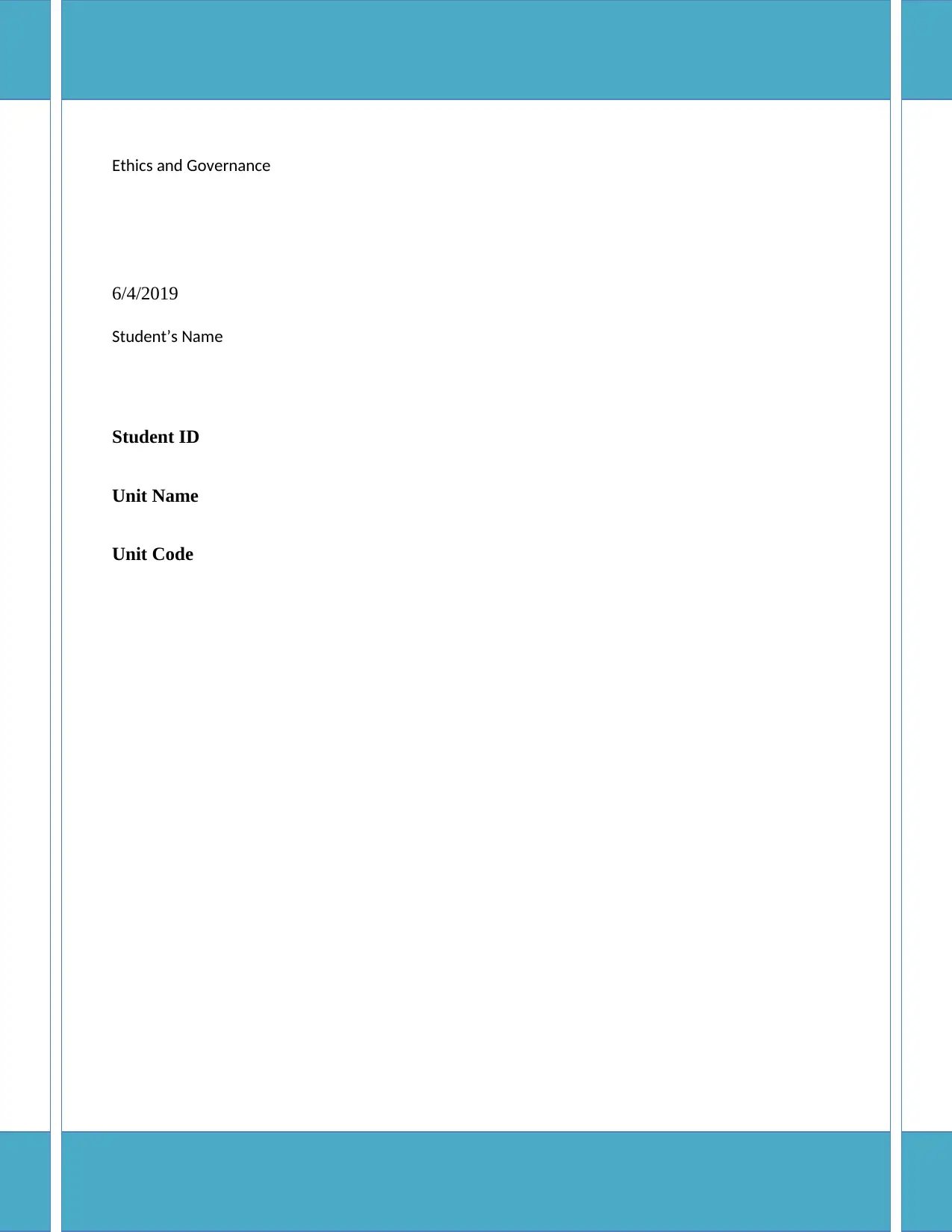
Running Head: BUSINESS LAW ASSIGNMENT 0
Ethics and Governance
6/4/2019
Student’s Name
Student ID
Unit Name
Unit Code
Ethics and Governance
6/4/2019
Student’s Name
Student ID
Unit Name
Unit Code
Paraphrase This Document
Need a fresh take? Get an instant paraphrase of this document with our AI Paraphraser

ACCT20080 1
Contents
Executive Summary.........................................................................................................................2
Introduction......................................................................................................................................2
Summary of Company.....................................................................................................................2
Summary of corporate governance..................................................................................................3
Board Orientation............................................................................................................................5
Interpretation of company communication using Legitimacy Theory............................................8
Conclusion.....................................................................................................................................10
References......................................................................................................................................11
Contents
Executive Summary.........................................................................................................................2
Introduction......................................................................................................................................2
Summary of Company.....................................................................................................................2
Summary of corporate governance..................................................................................................3
Board Orientation............................................................................................................................5
Interpretation of company communication using Legitimacy Theory............................................8
Conclusion.....................................................................................................................................10
References......................................................................................................................................11
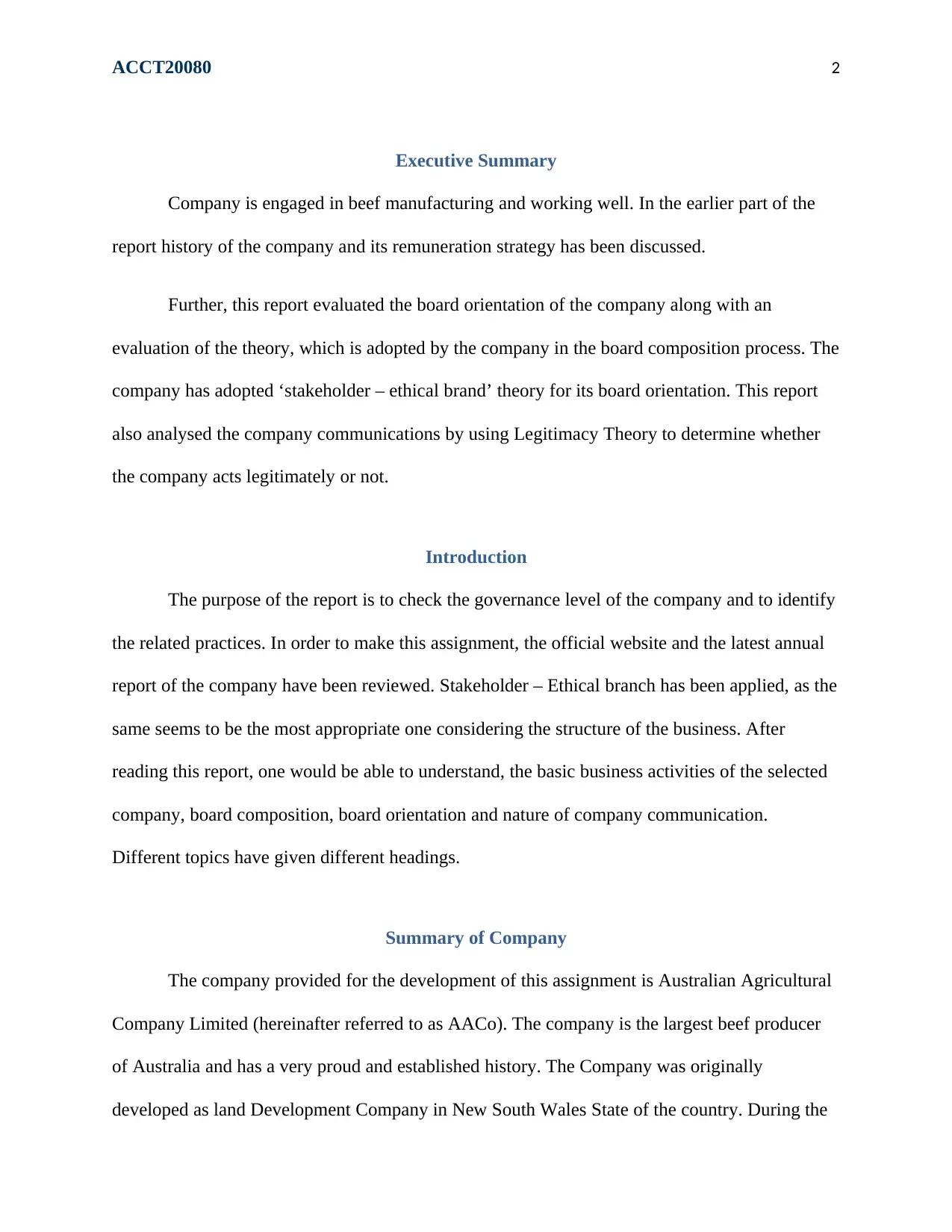
ACCT20080 2
Executive Summary
Company is engaged in beef manufacturing and working well. In the earlier part of the
report history of the company and its remuneration strategy has been discussed.
Further, this report evaluated the board orientation of the company along with an
evaluation of the theory, which is adopted by the company in the board composition process. The
company has adopted ‘stakeholder – ethical brand’ theory for its board orientation. This report
also analysed the company communications by using Legitimacy Theory to determine whether
the company acts legitimately or not.
Introduction
The purpose of the report is to check the governance level of the company and to identify
the related practices. In order to make this assignment, the official website and the latest annual
report of the company have been reviewed. Stakeholder – Ethical branch has been applied, as the
same seems to be the most appropriate one considering the structure of the business. After
reading this report, one would be able to understand, the basic business activities of the selected
company, board composition, board orientation and nature of company communication.
Different topics have given different headings.
Summary of Company
The company provided for the development of this assignment is Australian Agricultural
Company Limited (hereinafter referred to as AACo). The company is the largest beef producer
of Australia and has a very proud and established history. The Company was originally
developed as land Development Company in New South Wales State of the country. During the
Executive Summary
Company is engaged in beef manufacturing and working well. In the earlier part of the
report history of the company and its remuneration strategy has been discussed.
Further, this report evaluated the board orientation of the company along with an
evaluation of the theory, which is adopted by the company in the board composition process. The
company has adopted ‘stakeholder – ethical brand’ theory for its board orientation. This report
also analysed the company communications by using Legitimacy Theory to determine whether
the company acts legitimately or not.
Introduction
The purpose of the report is to check the governance level of the company and to identify
the related practices. In order to make this assignment, the official website and the latest annual
report of the company have been reviewed. Stakeholder – Ethical branch has been applied, as the
same seems to be the most appropriate one considering the structure of the business. After
reading this report, one would be able to understand, the basic business activities of the selected
company, board composition, board orientation and nature of company communication.
Different topics have given different headings.
Summary of Company
The company provided for the development of this assignment is Australian Agricultural
Company Limited (hereinafter referred to as AACo). The company is the largest beef producer
of Australia and has a very proud and established history. The Company was originally
developed as land Development Company in New South Wales State of the country. During the
⊘ This is a preview!⊘
Do you want full access?
Subscribe today to unlock all pages.

Trusted by 1+ million students worldwide
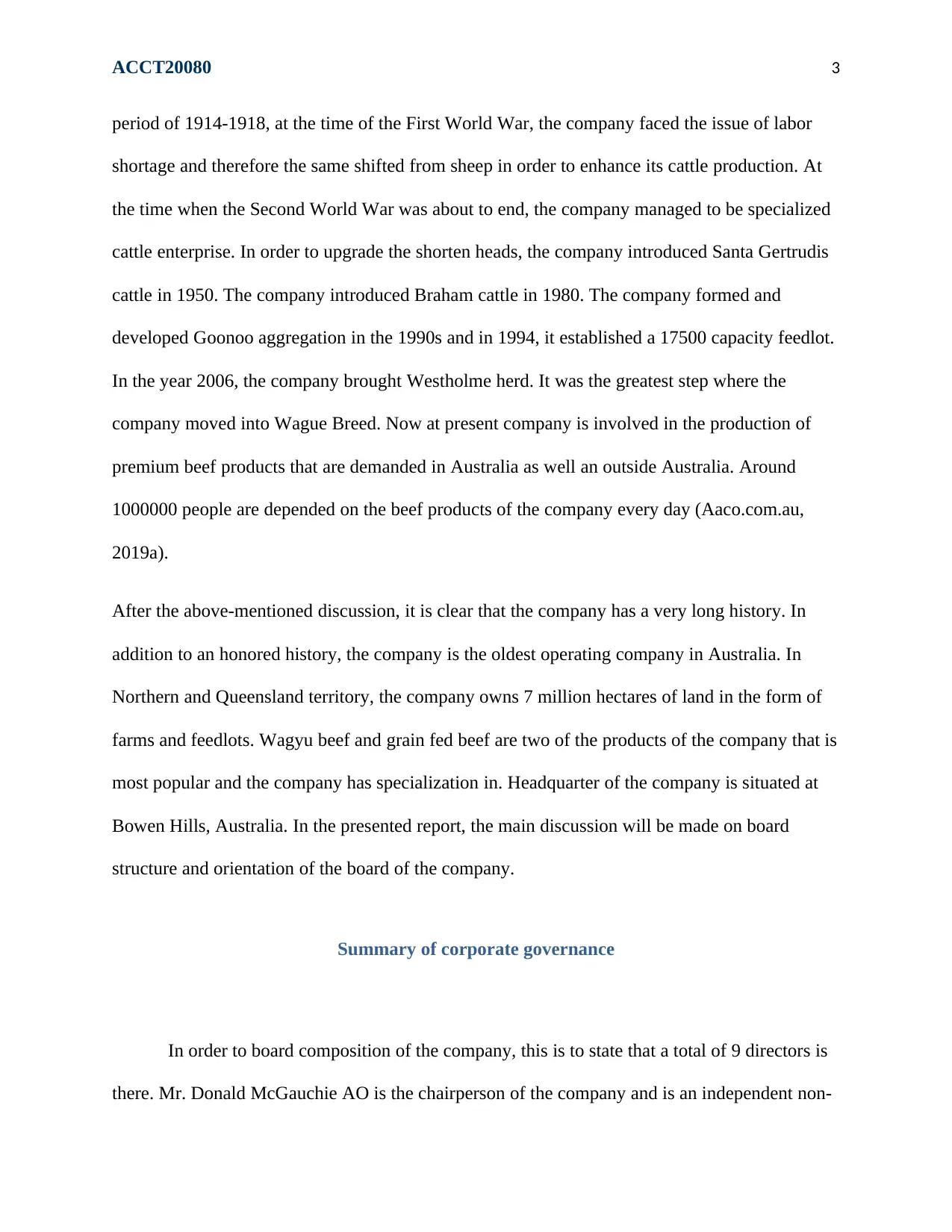
ACCT20080 3
period of 1914-1918, at the time of the First World War, the company faced the issue of labor
shortage and therefore the same shifted from sheep in order to enhance its cattle production. At
the time when the Second World War was about to end, the company managed to be specialized
cattle enterprise. In order to upgrade the shorten heads, the company introduced Santa Gertrudis
cattle in 1950. The company introduced Braham cattle in 1980. The company formed and
developed Goonoo aggregation in the 1990s and in 1994, it established a 17500 capacity feedlot.
In the year 2006, the company brought Westholme herd. It was the greatest step where the
company moved into Wague Breed. Now at present company is involved in the production of
premium beef products that are demanded in Australia as well an outside Australia. Around
1000000 people are depended on the beef products of the company every day (Aaco.com.au,
2019a).
After the above-mentioned discussion, it is clear that the company has a very long history. In
addition to an honored history, the company is the oldest operating company in Australia. In
Northern and Queensland territory, the company owns 7 million hectares of land in the form of
farms and feedlots. Wagyu beef and grain fed beef are two of the products of the company that is
most popular and the company has specialization in. Headquarter of the company is situated at
Bowen Hills, Australia. In the presented report, the main discussion will be made on board
structure and orientation of the board of the company.
Summary of corporate governance
In order to board composition of the company, this is to state that a total of 9 directors is
there. Mr. Donald McGauchie AO is the chairperson of the company and is an independent non-
period of 1914-1918, at the time of the First World War, the company faced the issue of labor
shortage and therefore the same shifted from sheep in order to enhance its cattle production. At
the time when the Second World War was about to end, the company managed to be specialized
cattle enterprise. In order to upgrade the shorten heads, the company introduced Santa Gertrudis
cattle in 1950. The company introduced Braham cattle in 1980. The company formed and
developed Goonoo aggregation in the 1990s and in 1994, it established a 17500 capacity feedlot.
In the year 2006, the company brought Westholme herd. It was the greatest step where the
company moved into Wague Breed. Now at present company is involved in the production of
premium beef products that are demanded in Australia as well an outside Australia. Around
1000000 people are depended on the beef products of the company every day (Aaco.com.au,
2019a).
After the above-mentioned discussion, it is clear that the company has a very long history. In
addition to an honored history, the company is the oldest operating company in Australia. In
Northern and Queensland territory, the company owns 7 million hectares of land in the form of
farms and feedlots. Wagyu beef and grain fed beef are two of the products of the company that is
most popular and the company has specialization in. Headquarter of the company is situated at
Bowen Hills, Australia. In the presented report, the main discussion will be made on board
structure and orientation of the board of the company.
Summary of corporate governance
In order to board composition of the company, this is to state that a total of 9 directors is
there. Mr. Donald McGauchie AO is the chairperson of the company and is an independent non-
Paraphrase This Document
Need a fresh take? Get an instant paraphrase of this document with our AI Paraphraser

ACCT20080 4
executive director. No director of the company has been retired in the year 2018-19. Out of the
total nine directors, 6 directors are independent and other 3 are non-independent. The reason sue
that these directors are considered as non-independent is also mentioned under the annual report
of the company. In this manner, 66.66% of the directors of the company are independent. If to
talk about remuneration strategy of the company, this is to state that the same consider provisions
of Corporations Act 2001 while determining remuneration for different category of directors. In
the annual report of the company, the same provided separate remuneration report, which is
further divided into 10 headings. Firstly to discuss remuneration of executive directors this is to
state that such directors get total fixed remuneration that comprises superannuation, base salary,
and all the packaged benefits. This fixed remuneration has no link with the performance of
directors. Further, the company also grants short-term incentives to its executive directors that
are paid in cash. Such incentives are 80% based on the financial performance of the company
and 20% individual performance of directors. In case of successful project completion, some
other payments are also available to directors that have no link with the company’s performance.
The company provides two types of performance rights to directors namely Long-term incentives
and Deferred Equity Awards. Following is the current remuneration strategy of the company
with respect to executive directors
(Aaco.com.au, 2019b)
executive director. No director of the company has been retired in the year 2018-19. Out of the
total nine directors, 6 directors are independent and other 3 are non-independent. The reason sue
that these directors are considered as non-independent is also mentioned under the annual report
of the company. In this manner, 66.66% of the directors of the company are independent. If to
talk about remuneration strategy of the company, this is to state that the same consider provisions
of Corporations Act 2001 while determining remuneration for different category of directors. In
the annual report of the company, the same provided separate remuneration report, which is
further divided into 10 headings. Firstly to discuss remuneration of executive directors this is to
state that such directors get total fixed remuneration that comprises superannuation, base salary,
and all the packaged benefits. This fixed remuneration has no link with the performance of
directors. Further, the company also grants short-term incentives to its executive directors that
are paid in cash. Such incentives are 80% based on the financial performance of the company
and 20% individual performance of directors. In case of successful project completion, some
other payments are also available to directors that have no link with the company’s performance.
The company provides two types of performance rights to directors namely Long-term incentives
and Deferred Equity Awards. Following is the current remuneration strategy of the company
with respect to executive directors
(Aaco.com.au, 2019b)
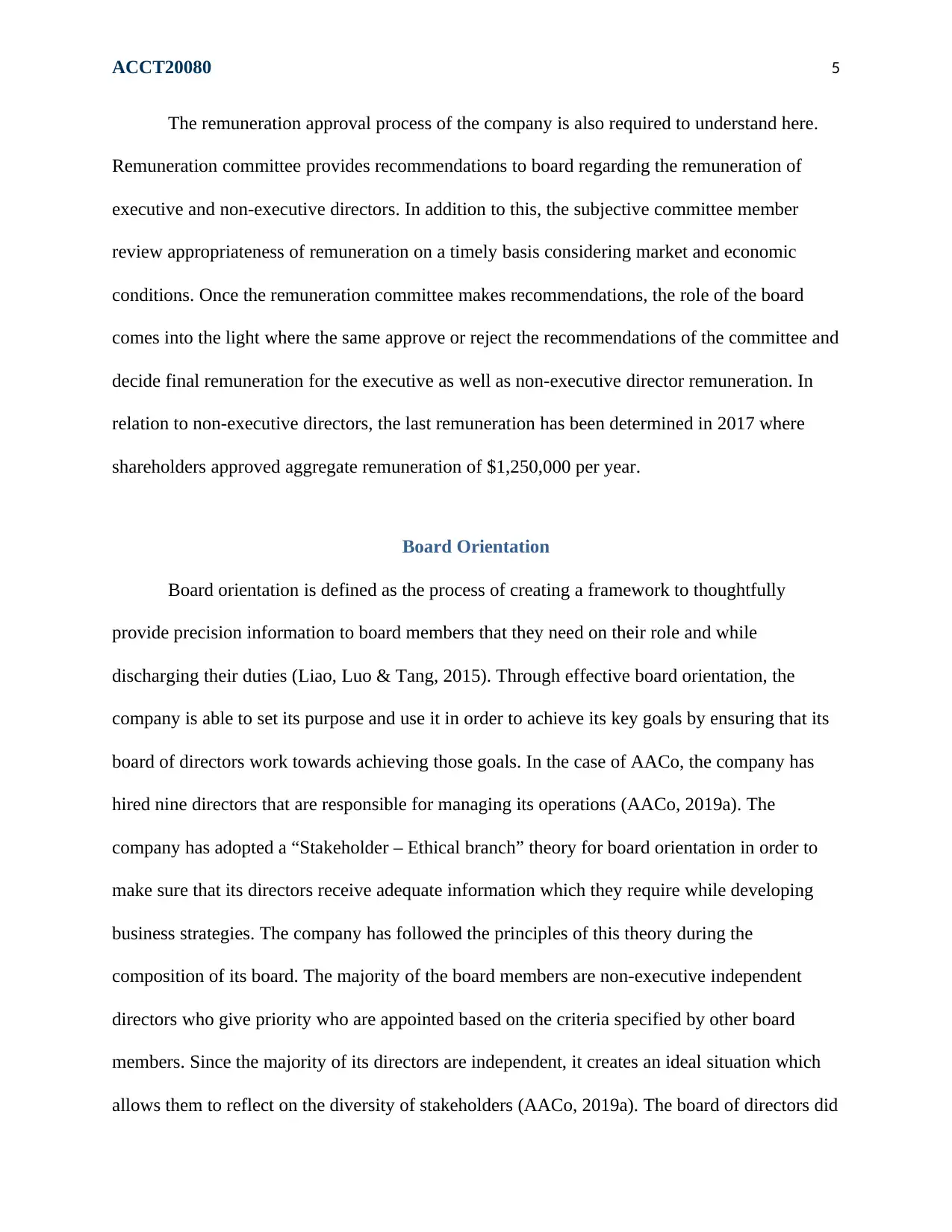
ACCT20080 5
The remuneration approval process of the company is also required to understand here.
Remuneration committee provides recommendations to board regarding the remuneration of
executive and non-executive directors. In addition to this, the subjective committee member
review appropriateness of remuneration on a timely basis considering market and economic
conditions. Once the remuneration committee makes recommendations, the role of the board
comes into the light where the same approve or reject the recommendations of the committee and
decide final remuneration for the executive as well as non-executive director remuneration. In
relation to non-executive directors, the last remuneration has been determined in 2017 where
shareholders approved aggregate remuneration of $1,250,000 per year.
Board Orientation
Board orientation is defined as the process of creating a framework to thoughtfully
provide precision information to board members that they need on their role and while
discharging their duties (Liao, Luo & Tang, 2015). Through effective board orientation, the
company is able to set its purpose and use it in order to achieve its key goals by ensuring that its
board of directors work towards achieving those goals. In the case of AACo, the company has
hired nine directors that are responsible for managing its operations (AACo, 2019a). The
company has adopted a “Stakeholder – Ethical branch” theory for board orientation in order to
make sure that its directors receive adequate information which they require while developing
business strategies. The company has followed the principles of this theory during the
composition of its board. The majority of the board members are non-executive independent
directors who give priority who are appointed based on the criteria specified by other board
members. Since the majority of its directors are independent, it creates an ideal situation which
allows them to reflect on the diversity of stakeholders (AACo, 2019a). The board of directors did
The remuneration approval process of the company is also required to understand here.
Remuneration committee provides recommendations to board regarding the remuneration of
executive and non-executive directors. In addition to this, the subjective committee member
review appropriateness of remuneration on a timely basis considering market and economic
conditions. Once the remuneration committee makes recommendations, the role of the board
comes into the light where the same approve or reject the recommendations of the committee and
decide final remuneration for the executive as well as non-executive director remuneration. In
relation to non-executive directors, the last remuneration has been determined in 2017 where
shareholders approved aggregate remuneration of $1,250,000 per year.
Board Orientation
Board orientation is defined as the process of creating a framework to thoughtfully
provide precision information to board members that they need on their role and while
discharging their duties (Liao, Luo & Tang, 2015). Through effective board orientation, the
company is able to set its purpose and use it in order to achieve its key goals by ensuring that its
board of directors work towards achieving those goals. In the case of AACo, the company has
hired nine directors that are responsible for managing its operations (AACo, 2019a). The
company has adopted a “Stakeholder – Ethical branch” theory for board orientation in order to
make sure that its directors receive adequate information which they require while developing
business strategies. The company has followed the principles of this theory during the
composition of its board. The majority of the board members are non-executive independent
directors who give priority who are appointed based on the criteria specified by other board
members. Since the majority of its directors are independent, it creates an ideal situation which
allows them to reflect on the diversity of stakeholders (AACo, 2019a). The board of directors did
⊘ This is a preview!⊘
Do you want full access?
Subscribe today to unlock all pages.

Trusted by 1+ million students worldwide
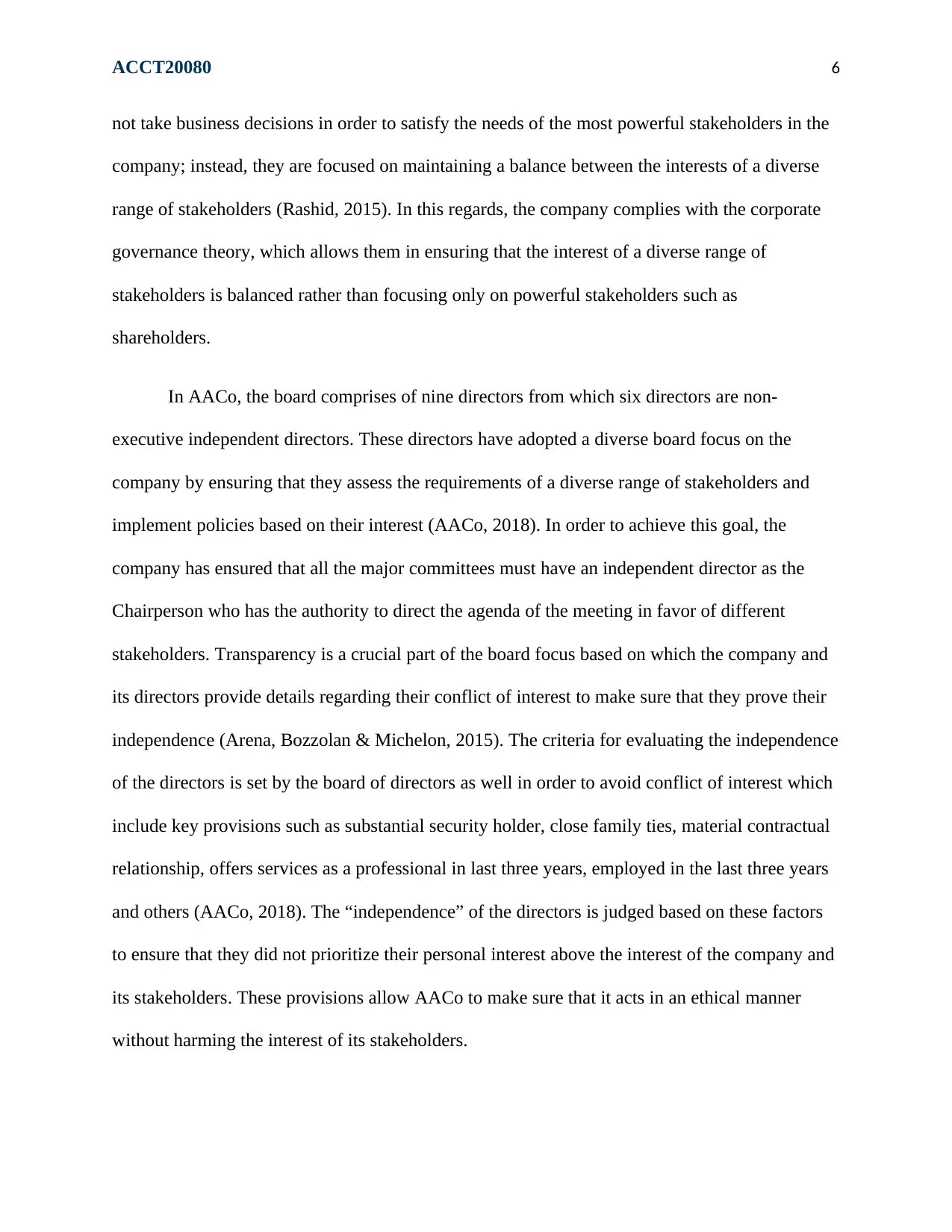
ACCT20080 6
not take business decisions in order to satisfy the needs of the most powerful stakeholders in the
company; instead, they are focused on maintaining a balance between the interests of a diverse
range of stakeholders (Rashid, 2015). In this regards, the company complies with the corporate
governance theory, which allows them in ensuring that the interest of a diverse range of
stakeholders is balanced rather than focusing only on powerful stakeholders such as
shareholders.
In AACo, the board comprises of nine directors from which six directors are non-
executive independent directors. These directors have adopted a diverse board focus on the
company by ensuring that they assess the requirements of a diverse range of stakeholders and
implement policies based on their interest (AACo, 2018). In order to achieve this goal, the
company has ensured that all the major committees must have an independent director as the
Chairperson who has the authority to direct the agenda of the meeting in favor of different
stakeholders. Transparency is a crucial part of the board focus based on which the company and
its directors provide details regarding their conflict of interest to make sure that they prove their
independence (Arena, Bozzolan & Michelon, 2015). The criteria for evaluating the independence
of the directors is set by the board of directors as well in order to avoid conflict of interest which
include key provisions such as substantial security holder, close family ties, material contractual
relationship, offers services as a professional in last three years, employed in the last three years
and others (AACo, 2018). The “independence” of the directors is judged based on these factors
to ensure that they did not prioritize their personal interest above the interest of the company and
its stakeholders. These provisions allow AACo to make sure that it acts in an ethical manner
without harming the interest of its stakeholders.
not take business decisions in order to satisfy the needs of the most powerful stakeholders in the
company; instead, they are focused on maintaining a balance between the interests of a diverse
range of stakeholders (Rashid, 2015). In this regards, the company complies with the corporate
governance theory, which allows them in ensuring that the interest of a diverse range of
stakeholders is balanced rather than focusing only on powerful stakeholders such as
shareholders.
In AACo, the board comprises of nine directors from which six directors are non-
executive independent directors. These directors have adopted a diverse board focus on the
company by ensuring that they assess the requirements of a diverse range of stakeholders and
implement policies based on their interest (AACo, 2018). In order to achieve this goal, the
company has ensured that all the major committees must have an independent director as the
Chairperson who has the authority to direct the agenda of the meeting in favor of different
stakeholders. Transparency is a crucial part of the board focus based on which the company and
its directors provide details regarding their conflict of interest to make sure that they prove their
independence (Arena, Bozzolan & Michelon, 2015). The criteria for evaluating the independence
of the directors is set by the board of directors as well in order to avoid conflict of interest which
include key provisions such as substantial security holder, close family ties, material contractual
relationship, offers services as a professional in last three years, employed in the last three years
and others (AACo, 2018). The “independence” of the directors is judged based on these factors
to ensure that they did not prioritize their personal interest above the interest of the company and
its stakeholders. These provisions allow AACo to make sure that it acts in an ethical manner
without harming the interest of its stakeholders.
Paraphrase This Document
Need a fresh take? Get an instant paraphrase of this document with our AI Paraphraser
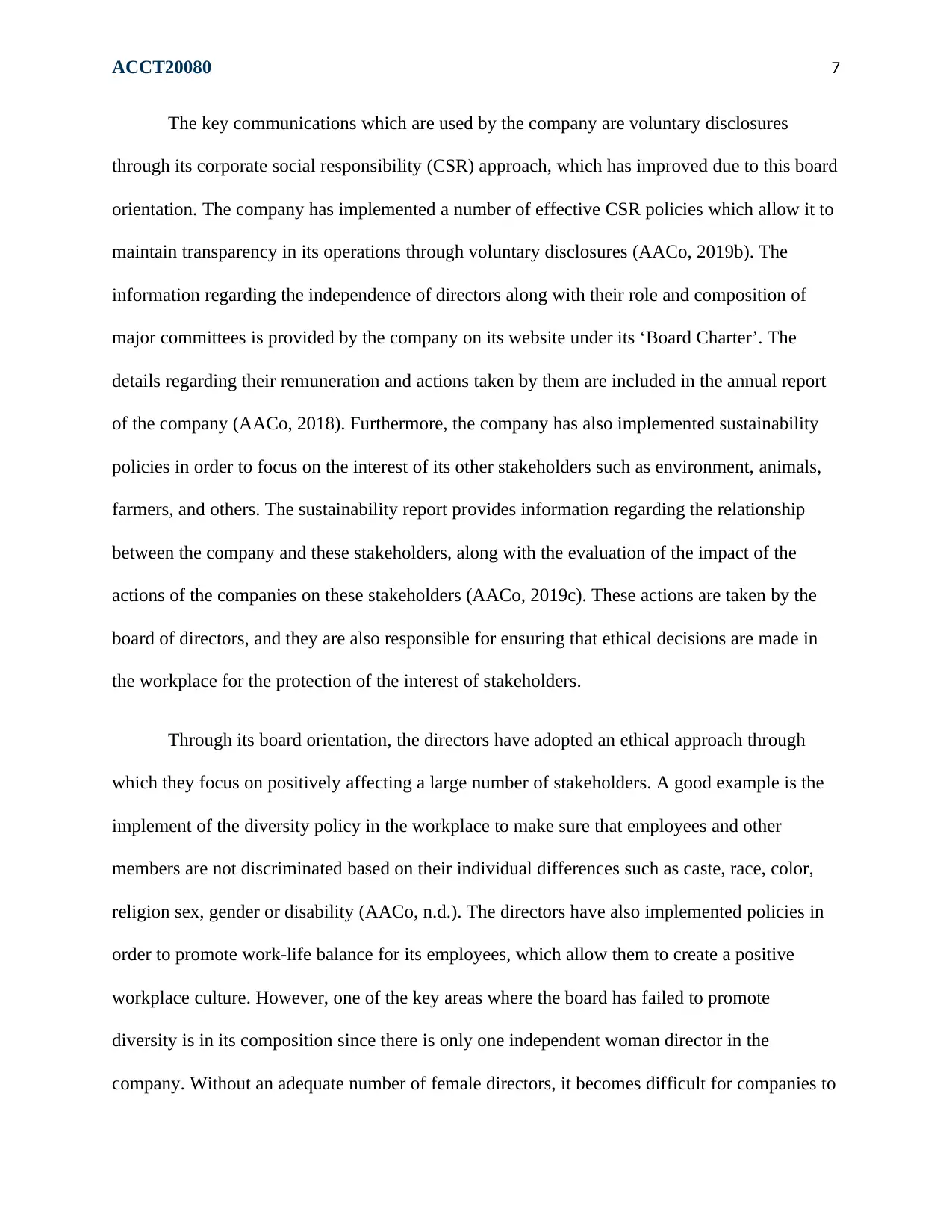
ACCT20080 7
The key communications which are used by the company are voluntary disclosures
through its corporate social responsibility (CSR) approach, which has improved due to this board
orientation. The company has implemented a number of effective CSR policies which allow it to
maintain transparency in its operations through voluntary disclosures (AACo, 2019b). The
information regarding the independence of directors along with their role and composition of
major committees is provided by the company on its website under its ‘Board Charter’. The
details regarding their remuneration and actions taken by them are included in the annual report
of the company (AACo, 2018). Furthermore, the company has also implemented sustainability
policies in order to focus on the interest of its other stakeholders such as environment, animals,
farmers, and others. The sustainability report provides information regarding the relationship
between the company and these stakeholders, along with the evaluation of the impact of the
actions of the companies on these stakeholders (AACo, 2019c). These actions are taken by the
board of directors, and they are also responsible for ensuring that ethical decisions are made in
the workplace for the protection of the interest of stakeholders.
Through its board orientation, the directors have adopted an ethical approach through
which they focus on positively affecting a large number of stakeholders. A good example is the
implement of the diversity policy in the workplace to make sure that employees and other
members are not discriminated based on their individual differences such as caste, race, color,
religion sex, gender or disability (AACo, n.d.). The directors have also implemented policies in
order to promote work-life balance for its employees, which allow them to create a positive
workplace culture. However, one of the key areas where the board has failed to promote
diversity is in its composition since there is only one independent woman director in the
company. Without an adequate number of female directors, it becomes difficult for companies to
The key communications which are used by the company are voluntary disclosures
through its corporate social responsibility (CSR) approach, which has improved due to this board
orientation. The company has implemented a number of effective CSR policies which allow it to
maintain transparency in its operations through voluntary disclosures (AACo, 2019b). The
information regarding the independence of directors along with their role and composition of
major committees is provided by the company on its website under its ‘Board Charter’. The
details regarding their remuneration and actions taken by them are included in the annual report
of the company (AACo, 2018). Furthermore, the company has also implemented sustainability
policies in order to focus on the interest of its other stakeholders such as environment, animals,
farmers, and others. The sustainability report provides information regarding the relationship
between the company and these stakeholders, along with the evaluation of the impact of the
actions of the companies on these stakeholders (AACo, 2019c). These actions are taken by the
board of directors, and they are also responsible for ensuring that ethical decisions are made in
the workplace for the protection of the interest of stakeholders.
Through its board orientation, the directors have adopted an ethical approach through
which they focus on positively affecting a large number of stakeholders. A good example is the
implement of the diversity policy in the workplace to make sure that employees and other
members are not discriminated based on their individual differences such as caste, race, color,
religion sex, gender or disability (AACo, n.d.). The directors have also implemented policies in
order to promote work-life balance for its employees, which allow them to create a positive
workplace culture. However, one of the key areas where the board has failed to promote
diversity is in its composition since there is only one independent woman director in the
company. Without an adequate number of female directors, it becomes difficult for companies to
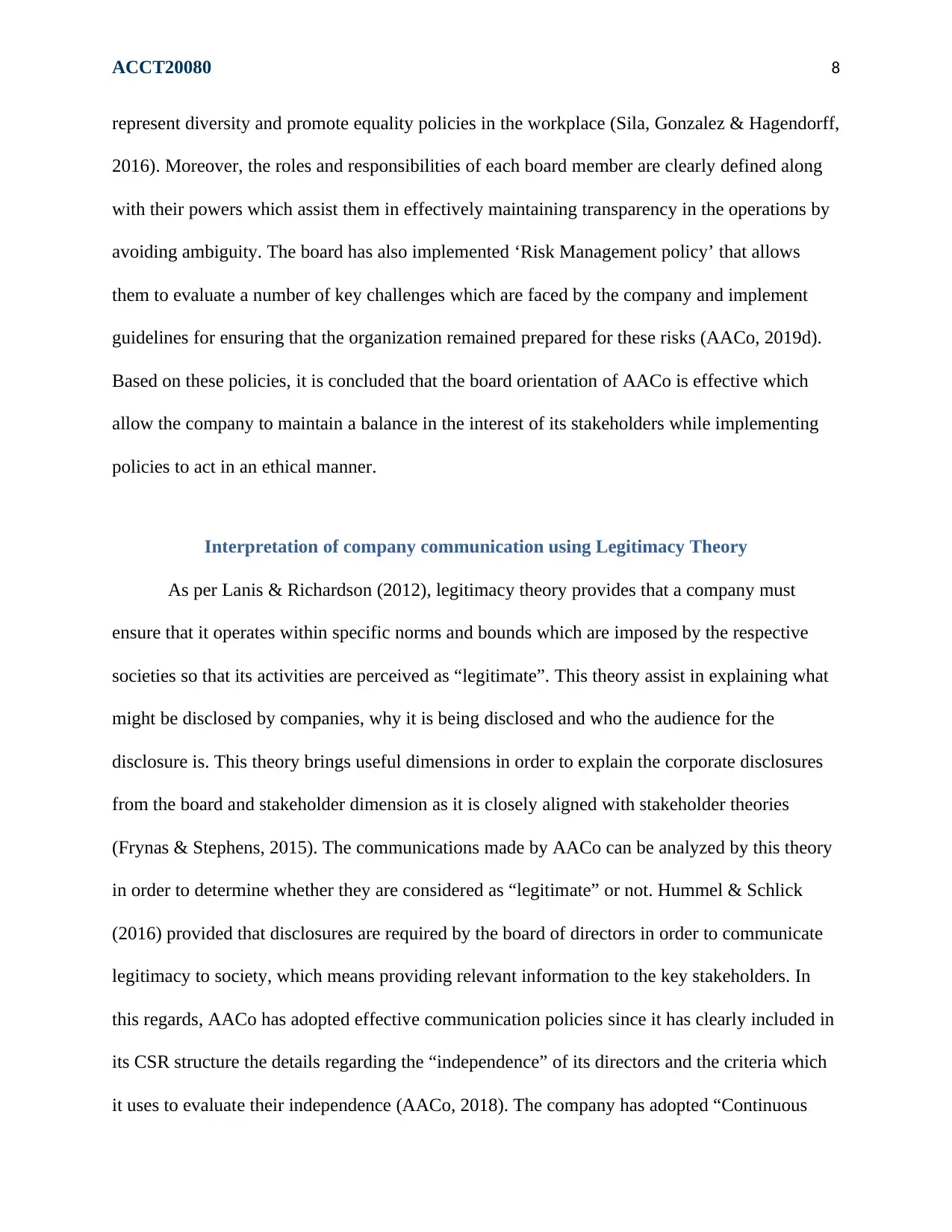
ACCT20080 8
represent diversity and promote equality policies in the workplace (Sila, Gonzalez & Hagendorff,
2016). Moreover, the roles and responsibilities of each board member are clearly defined along
with their powers which assist them in effectively maintaining transparency in the operations by
avoiding ambiguity. The board has also implemented ‘Risk Management policy’ that allows
them to evaluate a number of key challenges which are faced by the company and implement
guidelines for ensuring that the organization remained prepared for these risks (AACo, 2019d).
Based on these policies, it is concluded that the board orientation of AACo is effective which
allow the company to maintain a balance in the interest of its stakeholders while implementing
policies to act in an ethical manner.
Interpretation of company communication using Legitimacy Theory
As per Lanis & Richardson (2012), legitimacy theory provides that a company must
ensure that it operates within specific norms and bounds which are imposed by the respective
societies so that its activities are perceived as “legitimate”. This theory assist in explaining what
might be disclosed by companies, why it is being disclosed and who the audience for the
disclosure is. This theory brings useful dimensions in order to explain the corporate disclosures
from the board and stakeholder dimension as it is closely aligned with stakeholder theories
(Frynas & Stephens, 2015). The communications made by AACo can be analyzed by this theory
in order to determine whether they are considered as “legitimate” or not. Hummel & Schlick
(2016) provided that disclosures are required by the board of directors in order to communicate
legitimacy to society, which means providing relevant information to the key stakeholders. In
this regards, AACo has adopted effective communication policies since it has clearly included in
its CSR structure the details regarding the “independence” of its directors and the criteria which
it uses to evaluate their independence (AACo, 2018). The company has adopted “Continuous
represent diversity and promote equality policies in the workplace (Sila, Gonzalez & Hagendorff,
2016). Moreover, the roles and responsibilities of each board member are clearly defined along
with their powers which assist them in effectively maintaining transparency in the operations by
avoiding ambiguity. The board has also implemented ‘Risk Management policy’ that allows
them to evaluate a number of key challenges which are faced by the company and implement
guidelines for ensuring that the organization remained prepared for these risks (AACo, 2019d).
Based on these policies, it is concluded that the board orientation of AACo is effective which
allow the company to maintain a balance in the interest of its stakeholders while implementing
policies to act in an ethical manner.
Interpretation of company communication using Legitimacy Theory
As per Lanis & Richardson (2012), legitimacy theory provides that a company must
ensure that it operates within specific norms and bounds which are imposed by the respective
societies so that its activities are perceived as “legitimate”. This theory assist in explaining what
might be disclosed by companies, why it is being disclosed and who the audience for the
disclosure is. This theory brings useful dimensions in order to explain the corporate disclosures
from the board and stakeholder dimension as it is closely aligned with stakeholder theories
(Frynas & Stephens, 2015). The communications made by AACo can be analyzed by this theory
in order to determine whether they are considered as “legitimate” or not. Hummel & Schlick
(2016) provided that disclosures are required by the board of directors in order to communicate
legitimacy to society, which means providing relevant information to the key stakeholders. In
this regards, AACo has adopted effective communication policies since it has clearly included in
its CSR structure the details regarding the “independence” of its directors and the criteria which
it uses to evaluate their independence (AACo, 2018). The company has adopted “Continuous
⊘ This is a preview!⊘
Do you want full access?
Subscribe today to unlock all pages.

Trusted by 1+ million students worldwide
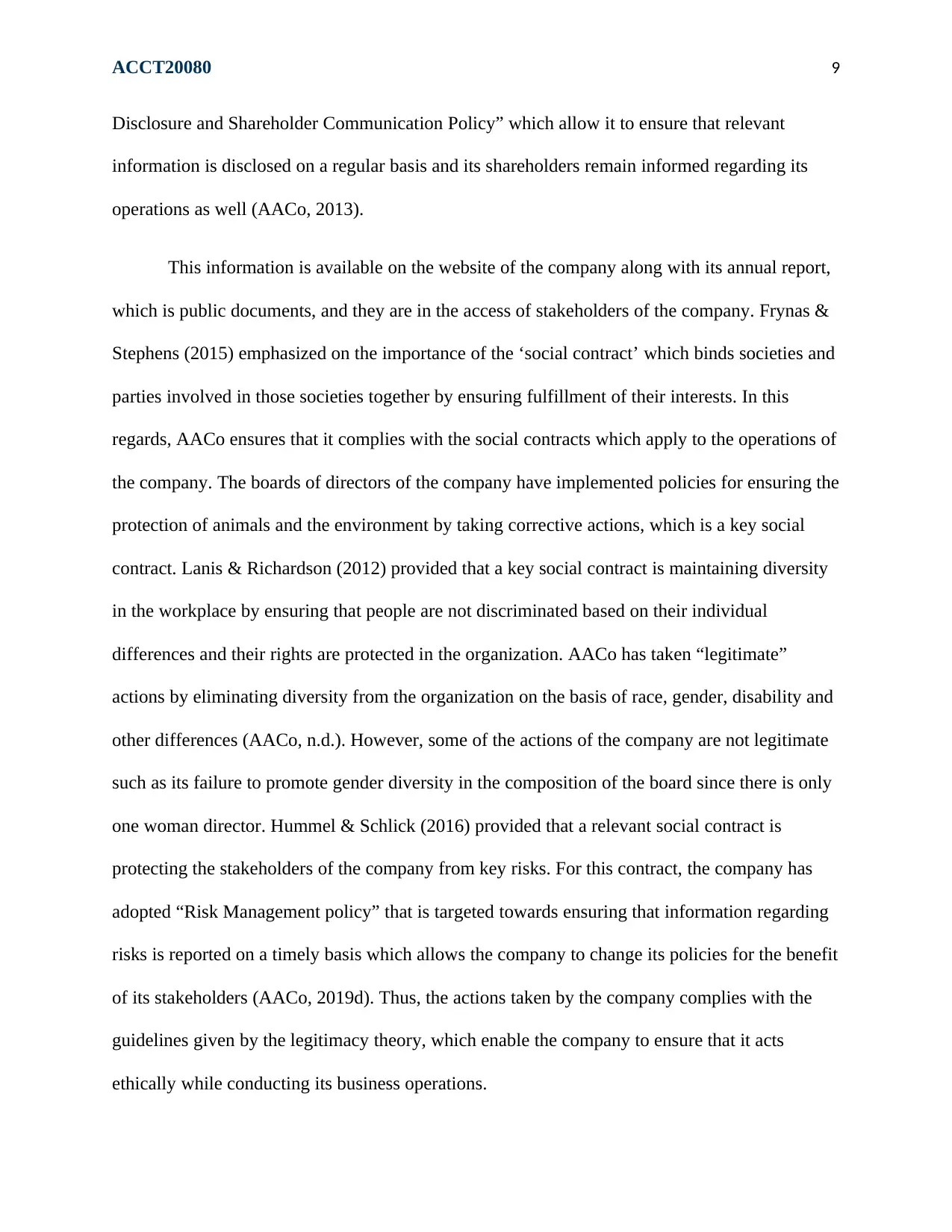
ACCT20080 9
Disclosure and Shareholder Communication Policy” which allow it to ensure that relevant
information is disclosed on a regular basis and its shareholders remain informed regarding its
operations as well (AACo, 2013).
This information is available on the website of the company along with its annual report,
which is public documents, and they are in the access of stakeholders of the company. Frynas &
Stephens (2015) emphasized on the importance of the ‘social contract’ which binds societies and
parties involved in those societies together by ensuring fulfillment of their interests. In this
regards, AACo ensures that it complies with the social contracts which apply to the operations of
the company. The boards of directors of the company have implemented policies for ensuring the
protection of animals and the environment by taking corrective actions, which is a key social
contract. Lanis & Richardson (2012) provided that a key social contract is maintaining diversity
in the workplace by ensuring that people are not discriminated based on their individual
differences and their rights are protected in the organization. AACo has taken “legitimate”
actions by eliminating diversity from the organization on the basis of race, gender, disability and
other differences (AACo, n.d.). However, some of the actions of the company are not legitimate
such as its failure to promote gender diversity in the composition of the board since there is only
one woman director. Hummel & Schlick (2016) provided that a relevant social contract is
protecting the stakeholders of the company from key risks. For this contract, the company has
adopted “Risk Management policy” that is targeted towards ensuring that information regarding
risks is reported on a timely basis which allows the company to change its policies for the benefit
of its stakeholders (AACo, 2019d). Thus, the actions taken by the company complies with the
guidelines given by the legitimacy theory, which enable the company to ensure that it acts
ethically while conducting its business operations.
Disclosure and Shareholder Communication Policy” which allow it to ensure that relevant
information is disclosed on a regular basis and its shareholders remain informed regarding its
operations as well (AACo, 2013).
This information is available on the website of the company along with its annual report,
which is public documents, and they are in the access of stakeholders of the company. Frynas &
Stephens (2015) emphasized on the importance of the ‘social contract’ which binds societies and
parties involved in those societies together by ensuring fulfillment of their interests. In this
regards, AACo ensures that it complies with the social contracts which apply to the operations of
the company. The boards of directors of the company have implemented policies for ensuring the
protection of animals and the environment by taking corrective actions, which is a key social
contract. Lanis & Richardson (2012) provided that a key social contract is maintaining diversity
in the workplace by ensuring that people are not discriminated based on their individual
differences and their rights are protected in the organization. AACo has taken “legitimate”
actions by eliminating diversity from the organization on the basis of race, gender, disability and
other differences (AACo, n.d.). However, some of the actions of the company are not legitimate
such as its failure to promote gender diversity in the composition of the board since there is only
one woman director. Hummel & Schlick (2016) provided that a relevant social contract is
protecting the stakeholders of the company from key risks. For this contract, the company has
adopted “Risk Management policy” that is targeted towards ensuring that information regarding
risks is reported on a timely basis which allows the company to change its policies for the benefit
of its stakeholders (AACo, 2019d). Thus, the actions taken by the company complies with the
guidelines given by the legitimacy theory, which enable the company to ensure that it acts
ethically while conducting its business operations.
Paraphrase This Document
Need a fresh take? Get an instant paraphrase of this document with our AI Paraphraser
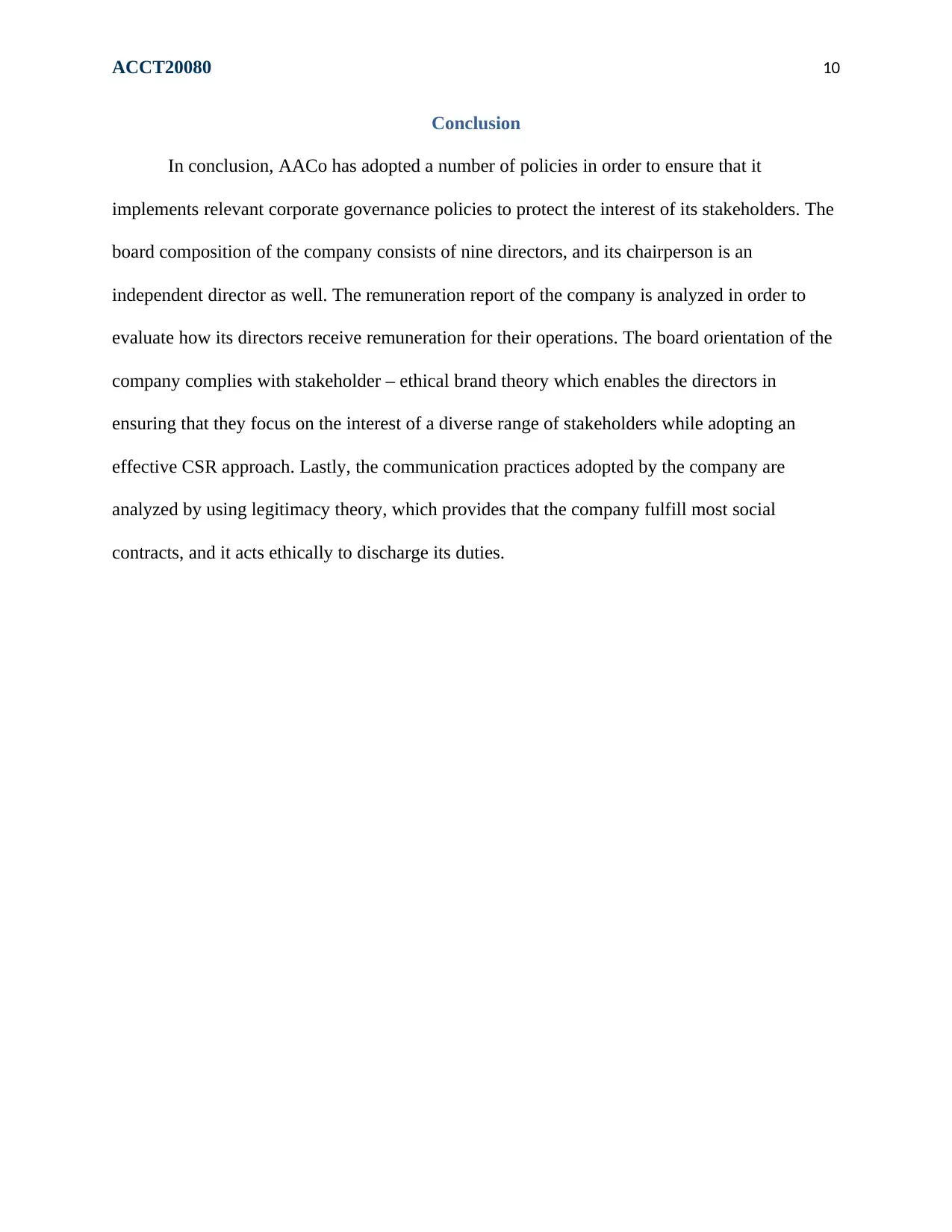
ACCT20080 10
Conclusion
In conclusion, AACo has adopted a number of policies in order to ensure that it
implements relevant corporate governance policies to protect the interest of its stakeholders. The
board composition of the company consists of nine directors, and its chairperson is an
independent director as well. The remuneration report of the company is analyzed in order to
evaluate how its directors receive remuneration for their operations. The board orientation of the
company complies with stakeholder – ethical brand theory which enables the directors in
ensuring that they focus on the interest of a diverse range of stakeholders while adopting an
effective CSR approach. Lastly, the communication practices adopted by the company are
analyzed by using legitimacy theory, which provides that the company fulfill most social
contracts, and it acts ethically to discharge its duties.
Conclusion
In conclusion, AACo has adopted a number of policies in order to ensure that it
implements relevant corporate governance policies to protect the interest of its stakeholders. The
board composition of the company consists of nine directors, and its chairperson is an
independent director as well. The remuneration report of the company is analyzed in order to
evaluate how its directors receive remuneration for their operations. The board orientation of the
company complies with stakeholder – ethical brand theory which enables the directors in
ensuring that they focus on the interest of a diverse range of stakeholders while adopting an
effective CSR approach. Lastly, the communication practices adopted by the company are
analyzed by using legitimacy theory, which provides that the company fulfill most social
contracts, and it acts ethically to discharge its duties.
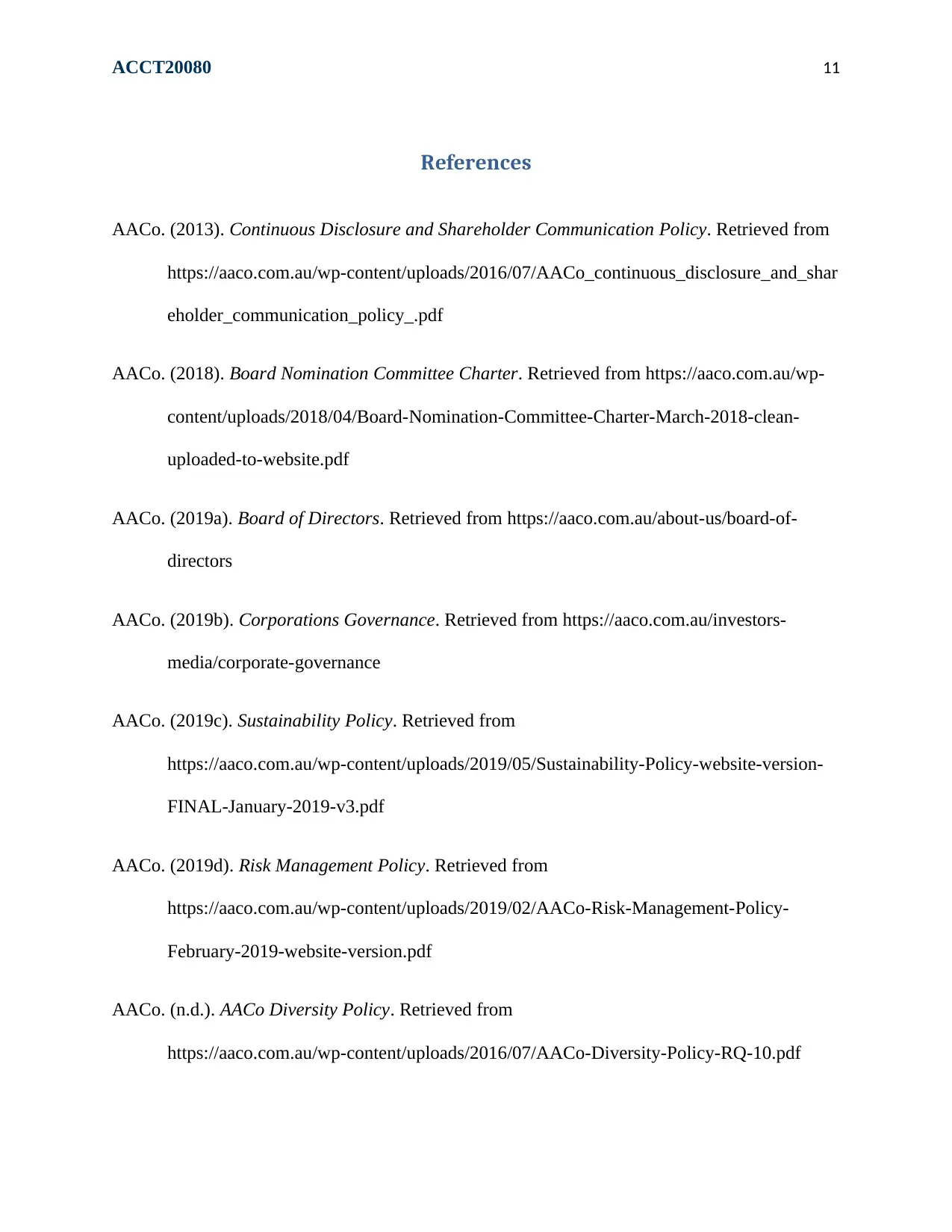
ACCT20080 11
References
AACo. (2013). Continuous Disclosure and Shareholder Communication Policy. Retrieved from
https://aaco.com.au/wp-content/uploads/2016/07/AACo_continuous_disclosure_and_shar
eholder_communication_policy_.pdf
AACo. (2018). Board Nomination Committee Charter. Retrieved from https://aaco.com.au/wp-
content/uploads/2018/04/Board-Nomination-Committee-Charter-March-2018-clean-
uploaded-to-website.pdf
AACo. (2019a). Board of Directors. Retrieved from https://aaco.com.au/about-us/board-of-
directors
AACo. (2019b). Corporations Governance. Retrieved from https://aaco.com.au/investors-
media/corporate-governance
AACo. (2019c). Sustainability Policy. Retrieved from
https://aaco.com.au/wp-content/uploads/2019/05/Sustainability-Policy-website-version-
FINAL-January-2019-v3.pdf
AACo. (2019d). Risk Management Policy. Retrieved from
https://aaco.com.au/wp-content/uploads/2019/02/AACo-Risk-Management-Policy-
February-2019-website-version.pdf
AACo. (n.d.). AACo Diversity Policy. Retrieved from
https://aaco.com.au/wp-content/uploads/2016/07/AACo-Diversity-Policy-RQ-10.pdf
References
AACo. (2013). Continuous Disclosure and Shareholder Communication Policy. Retrieved from
https://aaco.com.au/wp-content/uploads/2016/07/AACo_continuous_disclosure_and_shar
eholder_communication_policy_.pdf
AACo. (2018). Board Nomination Committee Charter. Retrieved from https://aaco.com.au/wp-
content/uploads/2018/04/Board-Nomination-Committee-Charter-March-2018-clean-
uploaded-to-website.pdf
AACo. (2019a). Board of Directors. Retrieved from https://aaco.com.au/about-us/board-of-
directors
AACo. (2019b). Corporations Governance. Retrieved from https://aaco.com.au/investors-
media/corporate-governance
AACo. (2019c). Sustainability Policy. Retrieved from
https://aaco.com.au/wp-content/uploads/2019/05/Sustainability-Policy-website-version-
FINAL-January-2019-v3.pdf
AACo. (2019d). Risk Management Policy. Retrieved from
https://aaco.com.au/wp-content/uploads/2019/02/AACo-Risk-Management-Policy-
February-2019-website-version.pdf
AACo. (n.d.). AACo Diversity Policy. Retrieved from
https://aaco.com.au/wp-content/uploads/2016/07/AACo-Diversity-Policy-RQ-10.pdf
⊘ This is a preview!⊘
Do you want full access?
Subscribe today to unlock all pages.

Trusted by 1+ million students worldwide
1 out of 14
Related Documents
Your All-in-One AI-Powered Toolkit for Academic Success.
+13062052269
info@desklib.com
Available 24*7 on WhatsApp / Email
![[object Object]](/_next/static/media/star-bottom.7253800d.svg)
Unlock your academic potential
Copyright © 2020–2025 A2Z Services. All Rights Reserved. Developed and managed by ZUCOL.





